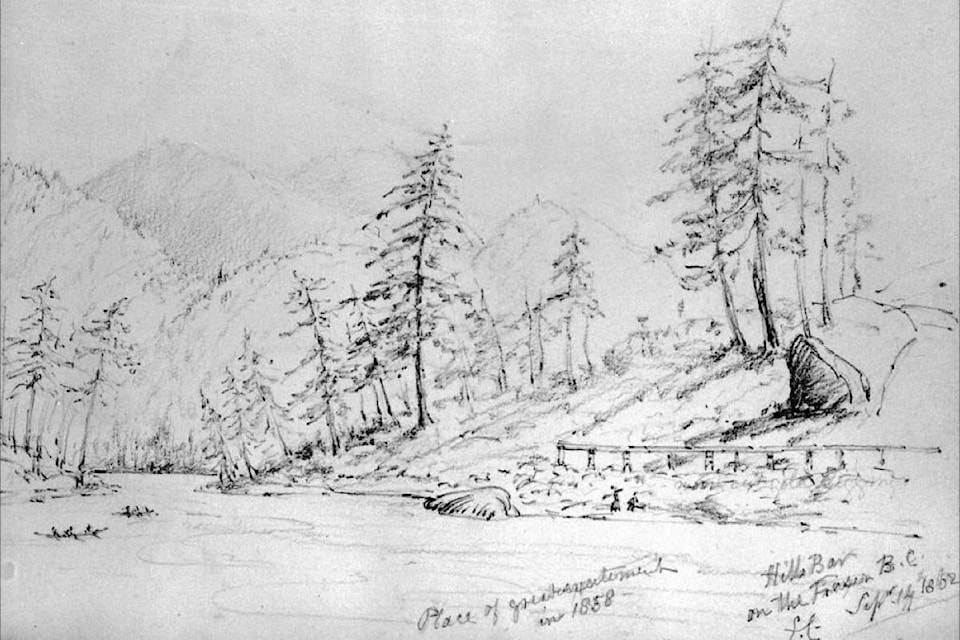In the last installment of this series about Yale during the gold rush days, we saw that Yorke’s House was the first roadhouse in Yale, in July 1858; but the honour of being the first roadhouse and saloon in the area goes to one built by French-Canadian Pierre Marquais at Hill’s Bar, one mile south of Yale, in June 1858. Nearby, close to 40 log cabins were being built, while a boarding-house built by Kerrison and Company to house miners belonging to their consortium was soon constructed, and there were plans to develop a townsite at the spot.
Why such activity at a place that is today all but forgotten? The simple answer is gold. Hill’s Bar was the longest-worked bar on the lower Fraser, and in 1858 was the richest piece of real estate in the colony. By October 1858 there were as many as 3,000 miners working the Fraser between Hope and Yale, and 400 of them were at Hill’s Bar, from which a staggering amount of gold was extracted. Between December 1858 and April 1859 two partners took out 46 pounds of gold, and by 1875 the value of the gold extracted from the bar was estimated to be $2 million (approximately $42 million today).
The discovery of gold at Hill’s Bar was made by pure chance. On March 12, 1858, a party of miners left San Francisco and headed north to the Fraser River. One of them was 25-year-old James Moore, and on March 23 (his 26th birthday) Moore and a small party of other men stopped for lunch at a small bar—half-a-mile long, 60 feet wide, and five feet deep—south of Yale.
While they were eating, one member of the party, Edward Hill, noticed yellow glimmering through some moss growing on the rocks near him. He scooped up a handful of moss, pulled out his gold pan, and washed the moss in the river. Soon the others had all put down their lunches and grabbed their own pans; and it did not take them long to realize they had quite literally hit pay dirt.
Fifty years later, when Moore was recognized as the oldest pioneer miner in the province, he addressed a meeting in Victoria, saying that “When we located this mine we laid the foundation stone of mining in British Columbia… . I may go a little further, and say that we laid the foundation stone of British Columbia, and I am proud to have the honour of stating here tonight that I helped to lay that foundation stone.
“But, sir, I am sorry to say I am the only one left of that little party that discovered those mines on Hill’s Bar, as all my associates have crossed the great divide. I trust they have struck it rich and have a claim staked for their old partner.”
Grand and lovely words; but an eyewitness to the early goings-on at Hill’s Bar, and some of the men who were working it, paints a rougher picture. Late in July, 1858, 24-year-old David Williams Higgins arrived in Yale from San Francisco. Born in Halifax in 1864, Higgins was brought up in Brooklyn, New York, where he apprenticed as a printer. In 1852 he headed to California to strike it rich, but the gold rush was over, so he joined the San Francisco Morning Call newspaper as editor and part owner, only to sell his interest in 1858 and head north in search of gold.
By the time he arrived, however, all the viable claims had been staked, so Higgins took charge of Ballou’s Express office in Yale, and began writing articles about his experiences and observations for several California newspapers.
Higgins was that comparatively rare combination: a keen-eyed journalist with the imagination, insight, and way with words of a born storyteller. His accounts of the early days of Yale and the area bring the place and the people alive 160 years later; and he makes it clear that he did not have a high opinion of what he called the “Hill’s Bar roughs”.
“The discoverers of Hill’s Bar,” he wrote, “had been driven away from San Francisco by a Vigilance Committee… . The leader of the Hill’s Bar roughs was a man named Ned McGowan. He had been a judge, a member of the legislature, a newspaper editor, and an all-round bad man. Had the Vigilance Committee caught him he would have been hanged, but he eluded them and came … with many others of his class to New Caledonia, as the mainland of British Columbia was then called.
“One of his friends was John Bagley, a former leading politician at San Francisco, who had also been driven away. These men gathered some of their kidney about them and proceeded to wreak their vengeance on such members of the Vigilance Committee as came in their way on the Fraser River. Many persons having been brutally assaulted and all but killed by the gang left the country lest worse things should befall them.”
Higgins describes a dinner and reception given for about two dozen members of Yale’s “high society” by the second Gold Commissioner, Peter Channell, to which the “Hill’s Bar gang” were pointedly not invited. The dinner ended in confusion, with a drunken Channell cutting and thrusting with his sabre, to the alarm of his guests, who fled into the snow without coats, hats, galoshes, or lanterns to put as much distance between themselves and Channell’s sabre as possible.
“The glee of the Hill’s Bar gang … was unbounded,” writes Higgins. “They came up to town in a body, and having got drunk their comments on the ‘swell’ members of Yale society … were rich and rare and racy.”
In the next instalment, liquor creates its own problems at Hill’s Bar, and the “bustle and excitement” of early Yale is described by one who was there.
editorial@accjournal.ca
Like us on Facebook and follow us on Twitter
